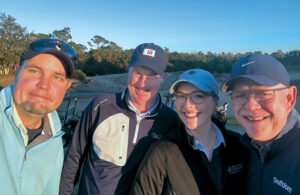Off the Record: A look back at 40 years of cool-season turfgrass research
We have general article topics and guidelines for each issue of Golfdom. Sometimes, finding the latest information in peer review journals or USGA Davis Program research summaries takes me a while. Thank goodness for the Turfgrass Information File at Michigan State University and internet search engines.
Review articles are a lot of work. While with the USGA, a constant request was to summarize all of the research on a particular subject. We accomplished this by sponsoring symposia at professional meetings or working with another interested association. Sometimes I attempted to write a review for a meeting or the USGA Green Section Record.
So, I wanted to find something on turfgrass water conservation for June. WOW, did I find a gem! Actually two.
Professors Ross Braun, Ph.D., Dale Bremer, Ph.D., Scott Ebdon, Ph.D., Jack Fry, Ph.D., and Aaron Patton, Ph.D., summarized hundreds of cool-season turfgrass water use articles in a two-part crop science review.
History lesson
In part one, the group presents the history of early water conservation and quantification methods in turfgrass and summarizes research on cool-season turfgrass evapotranspiration (ET) and deficit irrigation. The second part of the article summarizes research on cool-season turfgrass drought resistance completed since 1980.
Summaries of research from more than 60 experiments related to ET include: measured ET rates in various climates; comparisons of actual ET to estimated ET; crop coefficients; deficit irrigation; and how plant characteristics and management practices influence ET.
They summarize daily evapotranspiration (ETc in mm per day) rates for bentgrasses (6.12), fine fescues (5.52), tall fescue (7.79), ryegrasses (5.90) along with bluegrasses (5.35). The overall ETc is 6.25 mm per day for all the cool-season grasses.
The average crop coefficients range from 0.85 to 0.95 mm with seasonal variation. The minimum deficit irrigation replacement levels to produce acceptable turfgrass quality ranged from 59 to 74 percent of ET under different irrigation levels.
Free for all
In part two, research on greater than 30 field experiments evaluating drought response to irrigation amounts, length of dry down, and the influence of environmental and management factors. Most of the research was on the intraspecies variation of Kentucky bluegrass and tall fescue varieties.
This group of turfgrass researchers recommends more investigation into crop coefficients among cultivars within species, cultural influences, deficit irrigation replacement levels and standardizing measurement protocol to improve consistency in crop coefficients across future turfgrass experiments.
They suggest further investigating differences in drought resistance strategies among plants and management practices, shoot and root responses, subsequent recovery and inter- and intraspecies variation in cool-season turfgrasses, especially in northern climatic regions where cool-season turf species are adapted.
These two articles provide an excellent review of cool-season turfgrass water use. I was fortunate to see much of this work firsthand over the last 40 years. I hope the USGA can provide some funding to the Crop Science Society of America to make the articles available to nonmembers.
Water conservation will continue to be one of golf’s most significant challenges in the future. Since the 1980s, the USGA invested heavily in supporting research on turfgrass water use. The USGA projects and research funded by allied turfgrass organizations provide a solid foundation to improve water management and the grasses we use for golf.
Several technologies are available that need vetting for daily golf use on golf courses. Multiple opportunities exist to reduce the water we need for golf courses significantly. Thankfully, we have completed much of the preliminary work, and the effort now is to get it in the hands of superintendents.

Photo: Mike Kenna, Ph.D.
Mike Kenna, Ph.D., retired director of research, USGA Green Section. Contact him at mpkenna@gmail.com.












